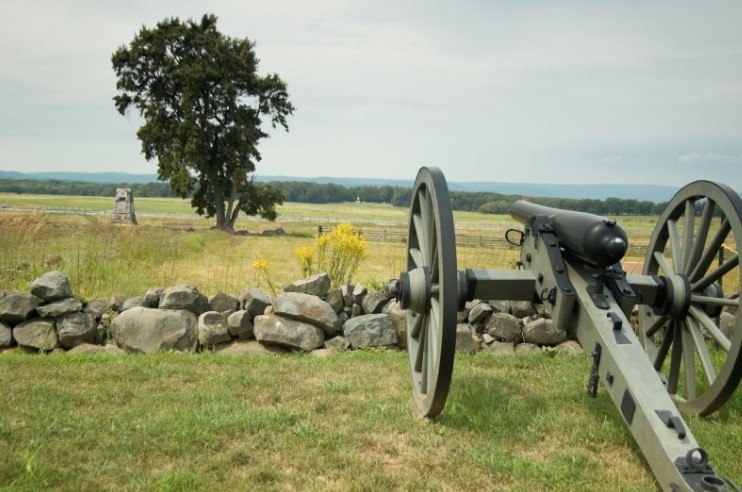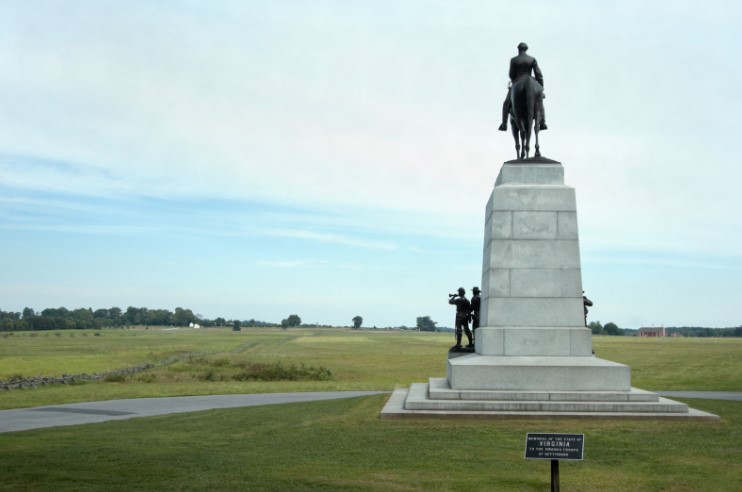
Revisiting Pickett’s Charge: Marching into the Fire
March 30, 2023The Battle of Gettysburg is often identified as the definitive turning point in the American Civil War. Fought from July 1st to July 3rd, 1863, in and around the Pennsylvania town from whence it takes its name, the famous battle resulted in the loss of over 50,000 soldiers on both sides, making it one of the bloodiest engagements in American history.
One of the most famous and controversial moments of the battle was “Pickett’s Charge,” a failed Confederate direct assault against the Union battlefront that has since become a symbol of gallant bravery and terrible sacrifice. Even today, 160 years later, the grim details of that terrible feat still echo across the empty fields where that final, brutal charge took place, and where so many desperate Confederate soldiers faultlessly obeyed their orders to march into the fire.
The Prelude to Pickett’s Charge
By the morning of July 3rd, the Battle of Gettysburg had been raging for two days. General Robert E. Lee, commander of the Confederate Army, had spent the previous two days applying pressure to various points on the Union lines, pressing the defenses of the Union position almost to the breaking point. He now decided the time had come to deliver the final blow by launching a massive assault against the mid-point of the Union lines, which he anticipated would be ill-defended and depleted of reinforcements. The plan was to have General George Pickett lead a combined force that included much of Lee’s fabled (and reputedly invincible) Army of Northern Virginia across the open field directly against the weakened Union center.
Lee knew he was taking a huge risk by doing so. But the only thing standing between his Confederate forces and an open road to the scantly defended Union capitol at Washington, DC, was the embattled Union army behind the low stone wall atop Cemetery ridge.
The Confederates preceded the maneuver with a massive hours-long barrage of focused artillery to weaken the Union defenses. When the bombardment ceased, the order was given for Pickett’s force to advance across the open field.
But Lee had miscalculated. The center of the Union lines was still heavily defended, and the lengthy barrage had amply signaled the Confederate intention in advance. Thus the Union troops were primed and ready for the hapless corps who began that long, dreadful march over the exposed open field in Gettysburg.
The Assembled Ranks
General Pickett’s division was still fresh and had yet to see action at Gettysburg, therefore they were chosen to lead the assault. But also among the Confederate soldiers who participated in Pickett’s Charge was the heart of Lee’s fabled Army of Northern Virginia, some of the hardiest and most experienced fighting men of the American Civil War. Skilled, brave, and determined, they were also exhausted and hungry after weeks of marching and fighting in the last Confederate invasion of the North. Supplies and ammunition were running low, and most of them had already been fighting nonstop for the last two days. But they unquestioningly obeyed Lee’s orders, having benefited from the General’s famed tactical acumen for three solid years of war. It was no secret that ultimate victory might be within their grasp if they could break the Union lines and divide the enemy forces, opening the road to Washington and the conquest of the North. The Confederate Army was at the height of its powers at that moment in time: they would never again have so many skilled soldiers, able commanders, available supplies, and ready ammunition all in the same place at the same time ever again. This was their chance.
They trusted their commanders to read the situation and to rightly gauge when and how to strike a fatal blow against their foe and lead them to victory. And Lee’s judgment had never failed them before, nor, they reasoned, would it do so now.
And so, when the Confederate cannon fire began to dwindle, the soldiers of Pickett’s charge assumed their formations and began to advance toward the enemy. They were met with the roar of Union cannon fire as the Federal troops commenced their own bombardment, turning the tables against the marching Confederates.
The long march had begun.
Into the Fire
At around 3 pm, the Confederate soldiers began their advance across the open field toward the Union positions. They were immediately met with a sustained barrage of artillery and small arms fire from the Union soldiers, who poured wave after wave of ordnance into the exposed Confederate force, firing from behind cover. Many of the approaching Confederates fell almost immediately, and a growing trail of fallen men soon marked the wake of the advancing rebels. Despite this, they closed ranks and continued their approach in the face of withering fire. Soldiers fell in droves, but the embattled marchers somehow continued to advance for around 30 minutes, eventually reaching (and breaching) one section of the Union lines at the area of Cemetery ridge now called “The Angle.”
That terrible half-hour must have seemed like an eternity to the attacking Confederates. Deafened by the sound of gunfire and artillery, partially blinded by smoke but still confronted by the intermittent sight of their comrades falling all around them— still, the Confederate soldiers pushed forward, their bodies pelted and harried by Union bullets. The effort was a valiant one but ultimately doomed to failure. The Confederates were unable to successfully break through the Union defenses. Pickett’s charge was a futile and costly last-ditch attempt to win the battle at any cost, but when all was said and done, its reckless excess would cost the Confederacy the war.
The Aftermath
Pickett’s Charge was a disaster for the Confederate Army. The soldiers who participated in the charge suffered heavy losses but ultimately achieved no tactical advantage. The charge has since been criticized as a reckless and unnecessary gamble, but it has also been hailed as a powerful representation of the bravery and sacrifice of the American fighting man, even in the face of the worst conditions that war might bring. The soldiers who took part in the charge knew that they could be marching to their own deaths, but still, they marched anyway, believing in their duty and trusting in the rightness of the cause they served. The results were horrifyingly brutal, both for the Confederate soldiers who marched into the Union lines and for the Union troops who met them there and mowed them down in waves.
The aftermath of Pickett’s Charge was a scene of total devastation. Thousands of Confederate soldiers lay dead or wounded on the battlefield; the cream of Southern military might, swept away forever in a mere half-hour of fierce fighting. The charge had cost the Confederate army dearly. Meanwhile, the Union victors caught their collective breath and realized that they had managed to hold firm against Lee’s formerly invincible forces. They now knew that ultimate victory might lay within reach, although it would take two more bloody years for it to be achieved.
The Legacy of Pickett’s Charge
Pickett’s Charge has become a symbol of the glory and futility of war. Thousands of soldiers were killed or wounded in the disastrous charge, with the Confederate army forced to retreat. The Union army had held its ground, and it was clear that the Confederate army would not be able to win the war. The Battle of Gettysburg would mark the turning point of the war, the results of which would inexorably lead to a Union victory.
The legacy of Pickett’s Charge would last long after the Battle of Gettysburg. It has been identified by many historians as the last great chance for Lee to achieve a decisive victory before time (and supplies) ran out. It marked the beginning of the end for the Confederate army, and with it, the Confederacy. The fact that so many men gave their lives so spectacularly in one last desperate toss of the dice, only to fail within sight of their goal, would see it go down in history as one of the most costly and futile actions of a terrible and tragic war.

The soldiers who fought and fell on both sides during Pickett’s Charge were heroes, but they were also victims. To this day, the now silent and picturesque location of Pickett’s Charge remains one of the most secretly terrible and sacred sites of the battlefield at Gettysburg.
Revisiting the Site Today
When one gazes out over the wide, open grassy fields where Pickett led his doomed charge, it is impossible not to feel a sense of overwhelming solemnity. The air here is heavy with the weight of history, and we are ever reminded of the bravery and courage of those who fought and died on this ground.
To stand upon the battlefield today is to be struck by the enormity of what occurred here. The scale of violence and destruction that took place here is difficult to fully comprehend. The carnage that took place here was no mere battle between armies; it was a battle between brothers.
This place where the past and present collide forces us to consider the folly of war and be reminded of the sacrifices made by those who fought and died here. To gaze upon this hallowed ground, to walk here and read the names inscribed on the monuments our forefathers have left for us, challenges each visitor to reflect on the lessons of history and to commemorate all who marched into the fire that day, and those who came through it.
Map of the Area near Pickett’s Charge
Following is a Google Map showing the location of Pickett’s Charge and other nearby landmarks at Gettysburg National Park:
Pickett’s Charge Map & Nearby Landmarks
Visit Gettysburg in Person
Plan your next excursion with us! Our bus tours of the historic Gettysburg Battlefield are active and ready to show you the sites of the historical battleground. Reservations can be made by calling our toll-free number at 877-680-8687. You can also purchase bus tour tickets online. Tours depart from the Gettysburg Tour Center located at 777 Baltimore St., Suite 100.